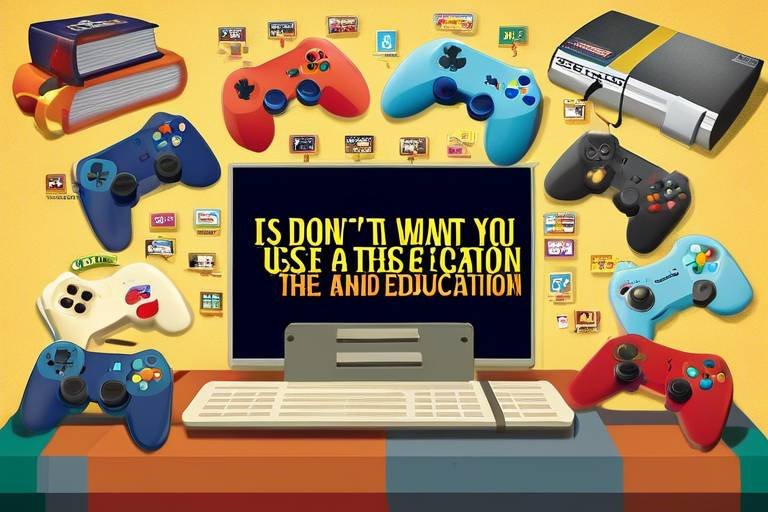The Impact of Technology on Child Development
In today's fast-paced world, technology is woven into the fabric of our daily lives, and its influence on child development is profound. As parents and caregivers, we often find ourselves grappling with the question: how does technology shape our children's cognitive, social, and emotional growth? While technology can be a powerful tool for learning and connection, it also poses challenges that we must navigate carefully. This article delves into the multifaceted impact of technology on young minds, exploring both the positive and negative effects it can have.
Technology has the potential to enhance cognitive skills in children by providing interactive and engaging learning experiences. Think of it as a digital playground where kids can explore, experiment, and learn at their own pace. For instance, educational apps and games can make complex subjects like math and science feel less intimidating and more accessible. However, it's essential to consider the flip side: as children become more reliant on digital content for information, they may experience decreased attention spans. It’s like having a buffet of knowledge at their fingertips, but they might forget how to savor the meal. Instead of deep, meaningful learning, they could end up skimming the surface.
The way children interact with others has transformed dramatically with the advent of technology. On one hand, digital platforms can foster connections with peers, allowing friendships to blossom across distances. On the other hand, this shift may hinder face-to-face communication skills, leading to a sense of social isolation. It’s a double-edged sword; while kids can connect with others online, they might miss out on the nuances of in-person interactions. Imagine trying to learn to swim in a pool but never getting into the water—eventually, you’ll need to dive in!
Many children today form friendships online, which can provide invaluable support and companionship. These virtual bonds can be a lifeline, especially for those who may struggle to connect in traditional social settings. However, it’s crucial to recognize that these relationships may lack the depth and emotional understanding that come with in-person interactions. Just like a plant needs sunlight to thrive, friendships need face-to-face time to grow strong and resilient.
Social media platforms offer children a way to connect, share, and express themselves. Yet, they can also expose them to the harsh realities of cyberbullying and the pressure of unrealistic comparisons. This can significantly affect their self-esteem and social skills. Picture a garden where some flowers bloom beautifully while others wilt under the weight of too much shade—children can feel the same way when faced with the challenges of social media.
Multiplayer games are another avenue where children can develop teamwork and collaboration skills. These games often require players to strategize and work together to achieve common goals, fostering a sense of community. However, excessive gaming can lead to the neglect of real-life relationships and responsibilities, much like a ship that sails too far from shore and risks getting lost at sea. Balance is key; enjoying gaming while still nurturing in-person connections is essential for healthy development.
Technology plays a dual role in emotional growth. On one hand, it provides resources for emotional regulation, such as apps that help children learn mindfulness techniques. On the other hand, overexposure to negative content can contribute to anxiety and depression. It’s a bit like a double-edged sword—while it can empower kids to manage their emotions, it can also expose them to overwhelming negativity. Parents must guide their children in navigating these digital waters to ensure they are equipped with the right tools.
Educational technology offers a plethora of learning tools that cater to various learning styles. From interactive games to online courses, the options are endless. However, it's vital to balance screen time with traditional learning methods for optimal development. Just as a well-rounded diet is essential for physical health, a balanced approach to education is crucial for cognitive growth.
Apps and games designed for learning can transform education into an engaging experience. When used appropriately, these tools can help children grasp complex concepts more easily. Imagine learning math through a fun game rather than a textbook—it's like turning a chore into an adventure!
The internet provides vast resources for learning, enabling children to explore topics of interest. However, it also requires guidance to navigate misinformation effectively. Just like a treasure hunt, children need a map to find the valuable information while avoiding the traps of falsehoods.
Establishing clear boundaries around technology use is crucial for healthy development. Parents and caregivers must create guidelines to ensure that technology serves as a beneficial tool rather than a hindrance. Think of it as setting the rules for a game; without them, chaos can ensue! By fostering a balanced approach to technology, we can help our children thrive in both the digital and real worlds.
- How much screen time is appropriate for children? The American Academy of Pediatrics recommends limiting screen time for children to ensure a healthy balance between digital and physical activities.
- Can technology improve learning outcomes? Yes, when used appropriately, technology can enhance learning by providing interactive and engaging educational tools.
- What are the signs of technology addiction in children? Signs may include excessive use, neglecting responsibilities, and withdrawal from social interactions.
- How can parents encourage healthy technology use? Establishing clear rules and encouraging outdoor play and face-to-face interactions can help promote a balanced lifestyle.

Cognitive Development
The impact of technology on in children is a fascinating topic that has sparked much debate among parents, educators, and psychologists alike. On one hand, technology can serve as a powerful tool for enhancing cognitive skills. With the rise of interactive learning experiences, children are now able to engage with educational content in ways that were unimaginable just a few decades ago. For instance, educational apps and games can make learning not only fun but also deeply engaging, allowing children to grasp complex concepts through visual and auditory stimuli. This kind of interactive learning can foster critical thinking and problem-solving skills, helping children develop a more profound understanding of the material they encounter.
However, it’s essential to consider the flip side of this technological boon. While children may be gaining knowledge, they may also be losing something equally important: their attention spans. With the constant barrage of information at their fingertips, many children find it challenging to focus on a single task for an extended period. The quick-paced nature of digital content can lead to a reliance on instant gratification, making it difficult for children to engage in activities that require patience and sustained attention. Have you ever noticed how quickly kids switch from one app to another? This behavior might be a sign of a diminishing ability to concentrate, which could have long-term implications for their academic success.
Moreover, the abundance of digital content available today raises questions about the quality of information children are consuming. While the internet is a treasure trove of knowledge, it’s also a minefield of misinformation. Children need guidance to navigate this vast landscape effectively. Parents and educators must play an active role in teaching children how to discern credible sources from unreliable ones. This skill is crucial not only for their cognitive development but also for their ability to engage as informed citizens in a digital world.
To summarize, technology has the potential to significantly enhance cognitive development in children through interactive learning and access to vast resources. However, it also poses challenges that can undermine attention spans and lead to information overload. Striking a balance between leveraging technology for educational purposes and ensuring that children develop essential cognitive skills in traditional settings is vital. As we navigate this complex landscape, it’s crucial to foster an environment where technology serves as a beneficial tool rather than a detrimental distraction.
- How does technology enhance cognitive skills in children?
Technology provides interactive and engaging learning experiences that can help children understand complex concepts more easily. - What are the downsides of technology on children's attention spans?
The rapid pace of digital content can lead to shorter attention spans, making it difficult for children to focus on tasks for extended periods. - How can parents help children navigate the internet safely?
Parents can guide children in discerning credible sources and encourage discussions about the information they encounter online.

Social Skills
The digital age has transformed the way children interact with one another, and the impact of technology on their is profound. On one hand, technology acts as a bridge, connecting children with peers across the globe, allowing them to forge friendships that would have been impossible just a few decades ago. Imagine a child in a small town forming a bond with another kid halfway around the world over a shared interest in video games or a favorite YouTube channel. This ability to connect can provide a sense of belonging and support that is crucial during formative years.
However, while technology facilitates these connections, it can also create a paradox. Many children are increasingly opting for virtual interactions over face-to-face communication. This shift can lead to a decline in essential social skills, such as reading body language, understanding social cues, and engaging in meaningful conversations. In fact, studies suggest that children who spend excessive time on screens may struggle with empathy and emotional intelligence, which are critical components of healthy relationships.
Moreover, the rise of social media platforms has introduced a new dimension to how children relate to one another. While these platforms allow for sharing and connecting, they can also expose children to the harsh realities of cyberbullying and unrealistic comparisons. For instance, a child scrolling through curated images of their peers might feel inadequate, impacting their self-esteem and willingness to engage socially. The pressure to maintain an online persona can be overwhelming, leading to anxiety and withdrawal from real-life interactions.
In the realm of virtual friendships, children often find solace and companionship online. These relationships can provide emotional support, especially for those who may feel isolated in their immediate surroundings. However, the depth of these friendships can be questionable. Unlike face-to-face interactions, online friendships may lack the nuances of emotional understanding and connection that come from in-person communication. It’s essential for parents to encourage a balance, ensuring that digital friendships do not replace the invaluable experiences of real-world interactions.
Social media platforms can be a double-edged sword. They allow children to connect with peers, share experiences, and express themselves creatively. Yet, the same platforms can expose them to negative influences, such as cyberbullying and harmful comparisons. The constant barrage of curated lives can distort a child’s perception of reality, leading to feelings of inadequacy and anxiety. Parents should guide their children in navigating these platforms, fostering a critical understanding of the content they consume and its impact on their self-image.
On a more positive note, group gaming can serve as a platform for developing teamwork and collaboration skills. Multiplayer games often require players to strategize together, communicate effectively, and work towards a common goal. This can foster a sense of camaraderie and teach valuable lessons about cooperation. However, it’s crucial to monitor gaming habits; excessive gaming can lead to neglect of real-life relationships and responsibilities. Striking a balance between virtual play and real-world interactions is key to ensuring that technology enhances, rather than hinders, social development.
Ultimately, technology's role in shaping social skills is complex. It offers both opportunities and challenges that can significantly influence how children develop and maintain relationships. By fostering open conversations about technology use and encouraging a blend of online and offline interactions, parents can help their children navigate this digital landscape more effectively.
- How can I encourage my child to develop social skills offline? Encourage activities that promote face-to-face interactions, such as team sports, clubs, or family gatherings.
- What are the signs that my child is struggling with social skills? Look for signs like difficulty making eye contact, avoiding social situations, or expressing anxiety about interactions.
- How much screen time is considered healthy for children? The American Academy of Pediatrics suggests that children aged 2 to 5 should have no more than one hour of high-quality programming each day, while older children should have consistent limits on screen time.

Virtual Friendships
In today's digital age, have become a significant part of children's social lives. These online relationships can offer a sense of belonging and companionship that is especially valuable for those who may struggle to connect in traditional social settings. Imagine a shy child who finds it hard to make friends at school; online platforms provide them with a space where they can express themselves freely and connect with peers who share similar interests. However, while these friendships can be comforting, they often lack the depth and emotional understanding that come from face-to-face interactions.
One of the most fascinating aspects of virtual friendships is the way they can transcend geographical boundaries. Children can connect with peers from different cultures and backgrounds, broadening their perspectives and understanding of the world. For instance, a child in the United States can play a multiplayer game with friends in Japan, learning about different cultures and lifestyles in the process. However, it's essential to recognize that these relationships can sometimes be superficial. The lack of physical presence can lead to misunderstandings and a diminished ability to read emotional cues, which are crucial for developing meaningful connections.
Moreover, the online world can be a double-edged sword. While virtual friendships can provide emotional support, they can also lead to feelings of loneliness and isolation when children rely solely on these connections. The excitement of receiving a message or a 'like' can be addictive, leading to an over-reliance on digital communication at the expense of real-life interactions. As parents and caregivers, it’s vital to encourage children to strike a balance between their online and offline lives. This could involve setting aside specific times for in-person playdates or family activities that foster deeper connections.
To better understand the dynamics of virtual friendships, consider the following table that outlines the pros and cons of these online relationships:
| Pros | Cons |
|---|---|
| Access to diverse friendships | Lack of emotional depth |
| Supportive communities | Potential for misunderstandings |
| Improved communication skills | Risk of cyberbullying |
| Opportunities for collaboration | Over-reliance on digital interaction |
In conclusion, while virtual friendships can play a significant role in a child's social development, it's crucial to maintain a healthy balance. Encouraging children to engage in both online and offline interactions can help them develop the social skills they need to thrive in the real world. After all, just like a garden needs both sunlight and water to flourish, children need a mix of virtual and real-life friendships to grow emotionally and socially.
- What are virtual friendships? Virtual friendships are relationships formed online, often through social media, gaming, or chat platforms, where individuals connect and interact without meeting in person.
- Are virtual friendships beneficial for children? Yes, they can provide support and companionship, especially for children who may struggle with face-to-face interactions. However, it's essential to balance these with in-person relationships.
- How can parents help their children manage virtual friendships? Parents can encourage their children to engage in offline activities, set time limits for online interactions, and discuss the importance of meaningful, face-to-face connections.

Impact of Social Media
Social media has become an integral part of our daily lives, and for children, it can be a double-edged sword. On one hand, platforms like Instagram, Snapchat, and TikTok offer a space for creativity and connection. Kids can share their thoughts, showcase their talents, and find communities that resonate with their interests. Imagine a young artist sharing their drawings with the world and receiving feedback from peers across the globe; it’s a beautiful thing! However, this digital playground is not without its pitfalls.
One of the most significant concerns surrounding social media is the risk of cyberbullying. Unlike traditional bullying, which can be confined to school hours and locations, cyberbullying can invade a child's home and personal space 24/7. The anonymity that social media provides can embolden individuals to say hurtful things they might never say face-to-face. This can lead to severe emotional distress, impacting a child's self-esteem and overall mental health.
Moreover, social media can create unrealistic comparisons. Children often see curated versions of others' lives, filled with perfect moments and filtered images. This can lead to feelings of inadequacy and anxiety, as they may feel pressure to live up to these unrealistic standards. It's essential for parents and caregivers to have open conversations about what children see online and to emphasize that social media often showcases a highlight reel rather than the full picture.
Additionally, while social media can foster connections, it can also lead to isolation. Kids might spend hours scrolling through feeds instead of engaging in face-to-face interactions. This can hinder the development of essential social skills, such as reading body language and understanding emotional cues. The irony is that while they are more connected than ever in a virtual sense, they may be missing out on the richness of in-person relationships.
It's crucial for parents to guide their children in navigating these platforms. Setting boundaries around screen time and encouraging real-life interactions can help mitigate the negative effects of social media. By fostering a healthy relationship with technology, children can enjoy the benefits of social media while being shielded from its potential harms. Remember, it’s all about balance!
- What age should children start using social media? It's generally recommended that children wait until they are at least 13 years old, as most platforms have age restrictions for safety reasons.
- How can parents monitor their child's social media use? Parents can use parental control apps, have regular discussions about online safety, and set clear guidelines regarding social media use.
- What are some signs that my child may be experiencing cyberbullying? Look for changes in behavior, such as withdrawal from social activities, sudden changes in mood, or a reluctance to use their devices.
- How can I help my child build a healthy relationship with social media? Encourage open communication about their online experiences, set limits on screen time, and promote real-life social interactions.

Group Gaming
Group gaming has become a significant aspect of childhood in the digital age, transforming the way children interact and build relationships. Multiplayer games allow kids to team up with friends or even strangers from around the globe, fostering a sense of community and collaboration. Imagine a group of children, each sitting in their own homes, yet they are united in a virtual world, strategizing together to conquer challenges. This shared experience can be incredibly enriching, teaching valuable skills like teamwork, communication, and problem-solving.
However, while the benefits of group gaming are undeniable, there’s a flip side to consider. Excessive gaming can lead to a neglect of real-life relationships and responsibilities. Children may find themselves so engrossed in their virtual worlds that they miss out on essential face-to-face interactions with family and friends. It’s like being at a party but spending all your time on your phone instead of engaging with those around you. This imbalance can create a disconnect from reality, leaving children feeling isolated despite their online connections.
Moreover, the nature of online interactions can sometimes be superficial. In many cases, friendships formed in gaming environments lack the depth and emotional understanding that come with in-person relationships. Children may feel a sense of camaraderie with their online teammates, but these bonds can be fragile. If a player decides to leave a game or a team, the emotional fallout can be significant, especially for younger children who are still learning how to navigate social dynamics.
To highlight the pros and cons of group gaming, let’s take a look at the following table:
| Pros of Group Gaming | Cons of Group Gaming |
|---|---|
|
|
In conclusion, while group gaming presents a unique opportunity for children to develop essential social skills and foster friendships, it’s crucial for parents and caregivers to monitor and guide their gaming habits. Finding a balance between virtual interactions and real-world relationships is key to ensuring that children benefit from these experiences without falling prey to the potential downsides.
Q: How can parents encourage healthy gaming habits?
A: Parents can set clear time limits on gaming, encourage breaks, and promote a mix of online and offline activities to ensure a well-rounded lifestyle.
Q: What are some signs that gaming is becoming a problem?
A: Signs include neglecting responsibilities, withdrawing from family and friends, and showing signs of irritability when unable to play.
Q: Are there educational benefits to group gaming?
A: Yes, many multiplayer games are designed to enhance critical thinking, teamwork, and communication skills, making them a valuable educational tool when used appropriately.

Emotional Development
Technology plays a dual role in the emotional development of children, acting as both a tool for growth and a potential source of distress. On one hand, it provides a wealth of resources that can aid in emotional regulation, offering children access to apps and online platforms that teach mindfulness, coping strategies, and even emotional intelligence. For instance, children can engage with interactive programs that guide them through managing feelings of anxiety or sadness. This can be particularly beneficial in a world where mental health awareness is becoming increasingly important.
However, the other side of the coin reveals a more troubling reality. With the rise of digital media, children are often bombarded with negative content, which can contribute to feelings of anxiety and depression. The constant exposure to distressing news, unrealistic portrayals of life on social media, and cyberbullying can create a toxic environment for young minds. Imagine a child scrolling through a feed filled with perfectly curated images and stories of others' lives—it's easy to see how that can lead to feelings of inadequacy and loneliness.
To illustrate this further, consider the following table that outlines both the positive and negative impacts of technology on emotional development:
| Positive Impacts | Negative Impacts |
|---|---|
| Access to emotional regulation apps | Exposure to cyberbullying |
| Online support communities | Comparison with unrealistic standards |
| Educational content on mental health | Overexposure to negative news |
Moreover, the emotional connections that children form through technology can be both profound and superficial. While they may find companionship through online friendships, these relationships often lack the depth and emotional understanding that comes with face-to-face interactions. A virtual hug, while comforting, cannot replace the warmth of a real one. This can lead to a sense of isolation, as children may prioritize their online interactions over nurturing real-world relationships.
In conclusion, while technology can serve as a valuable resource for emotional development, it is crucial for parents and caregivers to monitor and guide their children's technology use. By fostering an environment where technology enhances emotional growth rather than hinders it, we can help our children navigate the complex world of emotions in a healthy way.
- How can technology help with emotional development? Technology can provide access to resources like apps that teach coping strategies and emotional regulation.
- What are the risks of technology on children's emotional health? Overexposure to negative content and cyberbullying can contribute to anxiety and depression.
- Should parents limit screen time for emotional health? Yes, establishing boundaries around technology use can help promote healthier emotional development.
- Can online friendships be beneficial? While they can provide support, online friendships may lack the depth of in-person relationships.

Educational Benefits
In today's fast-paced world, technology has become a cornerstone of education, reshaping how children learn and interact with information. The **educational benefits** of technology are vast and varied, offering tools that cater to different learning styles and needs. For instance, children can access a plethora of resources online that allow them to dive deep into subjects they are passionate about. Imagine a child fascinated by dinosaurs; with just a few clicks, they can explore interactive websites, watch documentaries, and even participate in virtual museum tours. This kind of engagement can ignite a lifelong love for learning.
Moreover, educational technology often includes interactive learning tools such as apps and games that make learning fun and engaging. These tools can transform mundane subjects into exciting adventures. For example, a math app that incorporates gamification techniques allows children to solve problems while playing a game, making the learning process feel less like a chore and more like a challenge. When children are engaged, they are more likely to grasp complex concepts more easily and retain information longer.
However, while technology provides unprecedented access to information, it also comes with the responsibility of navigating this vast landscape wisely. The internet is filled with both valuable resources and misinformation. To truly reap the benefits of educational technology, children need guidance from parents and educators. They should learn not only how to find information but also how to evaluate its credibility. This critical thinking skill is essential in today’s information age.
To illustrate the impact of educational technology, consider the following table that highlights various tools and their respective benefits:
| Technology Tool | Benefits |
|---|---|
| Educational Apps | Interactive learning, personalized experiences, and instant feedback. |
| Online Courses | Access to expert knowledge, flexible learning pace, and diverse subjects. |
| Virtual Reality (VR) | Immersive experiences that enhance understanding of complex concepts. |
| Learning Management Systems (LMS) | Organized resources, tracking progress, and collaborative learning. |
In conclusion, while the integration of technology in education offers numerous advantages, it is vital to strike a balance between screen time and traditional learning methods. **Parents and caregivers** play a crucial role in this journey, ensuring that technology serves as a beneficial tool rather than a distraction. By setting guidelines and encouraging a healthy relationship with technology, we can help our children harness its power for educational success.
- How can I ensure my child is using educational technology effectively?
Monitor their usage, encourage exploration of reputable resources, and engage with them about what they are learning.
- What are some signs that my child is spending too much time on devices?
Look for changes in behavior, such as irritability, withdrawal from family activities, or declining grades.
- Are there specific apps you recommend for educational purposes?
Some popular educational apps include Khan Academy, Duolingo, and Scratch, which cater to various subjects and age groups.

Interactive Learning Tools
In today's digital age, have revolutionized the way children engage with educational content. Imagine a world where learning is not just about textbooks and lectures, but instead, it’s an exciting journey filled with vibrant apps and engaging games! These tools are designed to captivate young minds, making complex topics accessible and fun. For instance, educational games can transform a mundane math problem into an exhilarating quest, where children earn points and rewards for solving equations. This gamification of education not only enhances motivation but also fosters a deeper understanding of the material.
Moreover, interactive tools often cater to different learning styles, recognizing that every child is unique. Visual learners might benefit from video tutorials, while auditory learners may prefer podcasts or interactive quizzes. This personalization is crucial because it allows children to learn at their own pace, reducing frustration and increasing retention. With the right tools, a child who struggles with reading can use apps that read aloud, helping them to comprehend stories while simultaneously improving their literacy skills.
However, it's essential to approach these tools with a critical eye. Not all interactive learning tools are created equal. Some may prioritize entertainment over education, leading to a lack of substantial learning. To ensure that children are genuinely benefiting from these resources, parents and educators should look for tools that are not only engaging but also aligned with educational standards. Here’s a quick comparison of some popular interactive learning tools:
| Tool Name | Type | Age Group | Key Features |
|---|---|---|---|
| Kahoot! | Quiz Game | All Ages | Real-time quizzes, engaging competition |
| Duolingo | Language Learning | 8+ | Gamified language lessons, progress tracking |
| Scratch | Coding Platform | 8+ | Interactive coding projects, community sharing |
| Prodigy | Math Game | 6-14 | Adaptive math practice, fantasy game elements |
Incorporating these tools into a child’s routine can significantly enhance their educational experience. However, it’s crucial to maintain a balance. Too much screen time, even with educational content, can lead to burnout and decreased interest in learning. Therefore, integrating interactive tools with traditional learning methods—like reading physical books or engaging in hands-on activities—can create a well-rounded educational environment.
In conclusion, interactive learning tools are a powerful ally in modern education. They can make learning not just effective but also enjoyable. By choosing the right tools and balancing their use with traditional methods, we can ensure that children not only absorb knowledge but also develop a lifelong love for learning.
- What are interactive learning tools?
Interactive learning tools are digital resources such as apps, games, and online platforms designed to engage students in the learning process through interactive and often gamified experiences.
- How do I choose the right interactive learning tool for my child?
Look for tools that align with educational standards, cater to your child's learning style, and offer a balance of fun and educational value.
- Can too much screen time be harmful?
Yes, excessive screen time can lead to issues such as decreased attention spans and social isolation. It's essential to balance screen time with other activities.
- Are there interactive tools for all ages?
Yes, there are interactive learning tools available for various age groups, from preschoolers to high school students, covering a wide range of subjects.

Accessibility to Information
The internet has revolutionized the way children access information, opening up a world of knowledge at their fingertips. Imagine a vast library, but instead of needing to walk through its aisles, children can simply type a few keywords and instantly find resources on any topic they desire. This unprecedented accessibility empowers young minds to explore their interests deeply, fostering a sense of curiosity and encouraging independent learning. However, with great power comes great responsibility, and navigating this sea of information can be as overwhelming as it is enlightening.
While the internet serves as a treasure trove of educational materials, it also presents challenges. Children may encounter misinformation, making it crucial for parents and educators to guide them in distinguishing credible sources from unreliable ones. For instance, a child researching a science project might stumble upon a blog filled with pseudoscience instead of factual data. This highlights the importance of teaching critical thinking skills alongside digital literacy. Here are some key points to consider:
- Guidance is Essential: Parents should actively participate in their children's online research, helping them evaluate the reliability of sources.
- Encouraging Exploration: Children should be encouraged to ask questions and seek multiple perspectives on a topic to develop a well-rounded understanding.
- Promoting Healthy Skepticism: Teaching kids to question what they read online can help them become discerning consumers of information.
Moreover, the vastness of information available can sometimes lead to information overload, where children feel overwhelmed by the sheer volume of content. This can result in frustration and confusion, especially if they are not equipped with the skills to sift through and prioritize information effectively. To combat this, parents can help their children develop strategies for effective research, such as:
| Strategy | Description |
|---|---|
| Keyword Optimization | Teach children to use specific keywords to narrow down search results. |
| Source Evaluation | Guide them in assessing the credibility of websites and authors. |
| Summarization Techniques | Encourage them to summarize what they read to reinforce understanding. |
In conclusion, while the internet offers incredible opportunities for children to access information, it is essential for them to learn how to navigate this digital landscape responsibly. By fostering critical thinking and research skills, parents and educators can help children harness the power of technology to enhance their learning experiences without falling prey to its pitfalls.
Q1: How can I ensure my child is accessing reliable information online?
A1: Encourage your child to evaluate sources critically by checking the author's credentials, looking for citations, and comparing information across multiple sites.
Q2: What are some good resources for teaching digital literacy?
A2: Websites like Common Sense Media provide excellent guides and tools for parents to teach children about safe and effective internet use.
Q3: How much screen time is appropriate for children?
A3: The American Academy of Pediatrics recommends limiting screen time to no more than one hour per day for children aged 2 to 5, and encouraging consistent limits for older children to ensure a healthy balance.

Setting Boundaries
In today's digital age, where technology is woven into the fabric of our daily lives, around its use is more important than ever, especially for children. Think of technology as a powerful tool—like a double-edged sword. On one side, it offers incredible opportunities for learning and connection; on the other, it can lead to distractions, addiction, and unhealthy habits if not managed properly. So, how can parents and caregivers create a balanced environment that maximizes the benefits of technology while minimizing its drawbacks?
First and foremost, establishing clear guidelines is essential. This doesn’t mean imposing strict rules that feel punitive; rather, it’s about creating a framework that allows children to understand the importance of moderation. For instance, consider implementing a daily screen time limit that aligns with age-appropriate recommendations. The American Academy of Pediatrics suggests that children aged 2 to 5 should have no more than one hour of high-quality programming each day, while children aged 6 and older should have consistent limits on the time spent using screens. This approach not only encourages healthy habits but also fosters a sense of responsibility in children as they learn to manage their own time.
Another effective strategy is to designate specific areas and times for technology use. For example, setting up a tech-free zone during family meals can encourage conversation and connection, allowing everyone to engage without distractions. Similarly, establishing a "digital curfew" can help children wind down before bedtime, promoting better sleep hygiene. By creating a structured environment, children can learn to prioritize their responsibilities and relationships over their devices.
Moreover, it’s crucial to lead by example. Children are keen observers and often mimic the behaviors of adults. If parents are glued to their phones during family time, children will likely follow suit. By demonstrating healthy technology habits, such as putting devices away during meals or engaging in outdoor activities, parents can instill the same values in their children. This not only strengthens family bonds but also encourages children to develop their interests outside the digital realm.
Lastly, open communication about technology is vital. Encourage children to express their feelings about their online experiences, whether it’s excitement about a new game or concerns about cyberbullying. By fostering an environment where children feel comfortable discussing their digital lives, parents can address potential issues before they escalate. This dialogue also allows parents to educate their children about the importance of online safety, privacy, and the potential consequences of their digital actions.
In conclusion, setting boundaries around technology use is not about restricting freedom; it's about empowering children to make informed choices. By creating guidelines, designating tech-free zones, modeling healthy behaviors, and maintaining open lines of communication, parents can help their children navigate the digital landscape safely and effectively. Remember, technology can be a wonderful ally in child development, but it requires thoughtful management to ensure it serves as a positive influence.
- What is the recommended screen time for children? The American Academy of Pediatrics recommends no more than one hour of high-quality programming for children aged 2 to 5, and consistent limits for children aged 6 and older.
- How can I encourage my child to spend less time on screens? Set clear screen time limits, designate tech-free zones, and engage in alternative activities like sports or reading together.
- What should I do if my child is experiencing cyberbullying? Talk to your child about their experiences, encourage them to block the bullies, and report the behavior to the relevant platform.
Frequently Asked Questions
- How does technology impact cognitive development in children?
Technology can significantly enhance cognitive skills by providing interactive and engaging learning experiences. However, it may also contribute to shorter attention spans and a reliance on digital content for information, making it essential for parents to monitor usage.
- Can technology improve social skills in children?
While technology can help children connect with peers and foster relationships, it may also impede face-to-face communication, leading to social isolation. Balancing online interactions with real-life socialization is crucial for healthy social development.
- What are the effects of social media on children's emotional health?
Social media can offer a platform for connection, but it also exposes children to cyberbullying and unrealistic comparisons, which can negatively impact their self-esteem and emotional well-being. It's important for parents to discuss these issues with their children.
- Are virtual friendships beneficial for children?
Virtual friendships can provide companionship and support, but they often lack the depth and emotional understanding found in in-person relationships. Encouraging children to nurture both types of friendships is vital.
- How can educational technology benefit my child?
Educational technology offers diverse learning tools that cater to various learning styles. When used appropriately, interactive apps and games can make learning engaging and help children understand complex concepts more easily.
- What boundaries should I set around technology use?
Establishing clear boundaries is essential for healthy development. Parents should create guidelines regarding screen time, ensuring that technology serves as a beneficial tool rather than a distraction from real-life responsibilities and relationships.
- How can I help my child navigate misinformation online?
Teaching children how to critically evaluate sources and discern credible information is crucial. Encourage them to ask questions and seek guidance when exploring topics online to foster responsible internet use.


















